The history of Russian jewelry goes back over one thousand years. Many famous jewelers worked in Russia, and some, such as Fabergé have become household names.
Russian Jewelry has benefited from Russia’s own vast mineral reserves. The country has become a very important diamond producer and it is the second largest diamond-producing nation in the world today.
The Russian Jewelry market is important and has its particularities. Most foreign brands are present in Russia and successfully find their Russian customers. Apart from Fabergé, Russian brands face difficulties to find their legitimacy beside the foreign names of important Maisons with a long History.
Nine Centuries of History
The history of jewelry in Russia has roots stretching far back from the 9th to the 12th centuries. Ancient Russian cities of Velikiy Ustyug, Vologda, Kostroma, Nizhni Novgorod, Novgorod, Yaroslavl, St. Petersburg, Moscow were the centers of Russian gold smith’s work in various periods.
The brilliant age of Catherine II’s rule marked one of the heydays of Russian jeweler art. Production of jeweler factories of those times was characterized with an original combination of new forms and at the same time traditional Russian estheticism.
Charles Faberge’s jeweler house was founded in the second half of 19 centuries; it quickly won popularity and started executing orders of the imperial family. Faberge jeweler house supplied jewelries to almost all imperial and royal houses of Europe, Asia and Africa.
Modern masters continue traditions started by great jewelers of the pas and in the Orthodox tradition the patrons of jewelers are Sts. Cosmas and Damian. A holiday in their honor is called kuzminki and is marked twice a year – on July, 14th and November, 14th by Gregorian calendar. There are also regional holidays in honour of this trade.
The Diamond Fund
In 1719, Emperor Peter I « the Great » (reigned 1682-1725), founded the earliest version of what we now know as the State Diamond Fund of the Russian Federation. Peter I had visited other European nations, and introduced many innovations to Russia, one of which was the creation of a permanent fund to house a collection of jewels which belonged not to the Romanov family, but to the Russian State. Peter declared that the state holdings were inviolate, and could not be altered, sold, or given away – and he also decreed that each subsequent Emperor or Empress should leave a certain number of pieces acquired during their reign to the State, for the permanent glory of the Russian Empire. Peter left all of the pieces used in the coronation ceremony to the Diamond Fund, as well as many important pieces of 15th, 16th and 17th century jewelry. Emperors kept on contributing to the collection throughout centuries…
In 1914, with the threat of a possible German invasion due to World War I, the entire collection was carefully packed, and sent from St. Petersburg to Moscow, where it was placed in vaults beneath the Kremlin for safety. As Russia faced political troubles, including the Revolution in 1917 and the ensuing Russian Civil War, the jewels were forgotten for a time, and it was not until 1926 that they were found in the Kremlin. An enormous selection of the pieces, 70% of the original collections, were sold at Christie’s Auction house in London in 1927. The pieces which were sold were dispersed all over the globe, and many of their locations are now unknown. After the fall of communism, the remaining pieces went on display to the public, who can buy tickets to visit the diamond fund when they go to the Kremlin Armory Museum in Moscow.
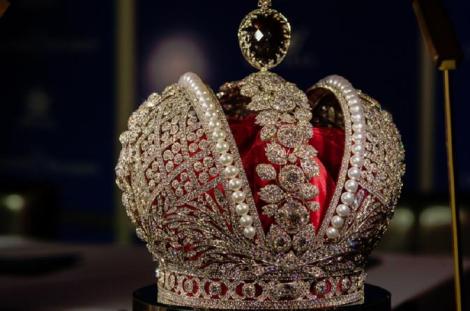
The Great Imperial Crown adorned with 5 000 diamonds of different size and made in the 18th century for the coronation of Catherine the Great
Fabergé
Peter Carl Faberge was born in 1846. His Protestant family originated in France, but fled after the Edict of Nantes was revoked in 1685 and some eventually settled in Russia. He apprenticed as a boy to his goldsmith father, Peter Carl Fabergé. By age 24, he had inherited his father’s jewelry workshop in St. Petersburg. He reorganized the business with the help of his brother Agathon. The two made copies of ancient Russian treasures and sold them.
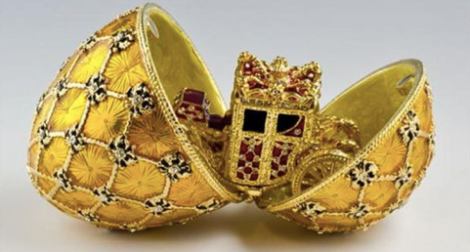
Faberge Egg
The Russian Diamonds
Although it stands to lose production from one of its best-producing deposits, Russia has hopes of soon increasing its diamond production. The future of the Russian diamond industry is closely tied to ALROSA. It is producing rather small types of diamonds. According to company officials, with the new goal, Alrosa could soon achieve a 30% share of the world’s diamond production.
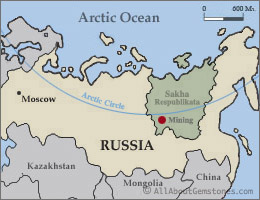
Mir Mine location
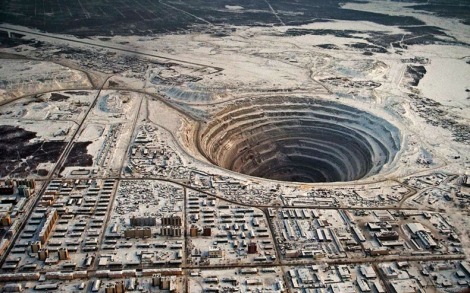
The Mir Mine
Production and Trade of Russian Diamonds
Russia is the second largest diamond-producing nation in the world after Botswana, now accounting for about 21% of the world’s diamond production. Diamond mining in Russia is carried out mainly in the Sakha Republic of Northeastern Russia, near the Arctic Circle.
Russian diamonds come from northeast Siberia, a cold but beautiful land of boreal forest and tundra in Russia’s vast interior. Diamonds from this region are free from violence and serious human rights abuses that too often plague diamond mining. Russian diamond mines also provide a critical source of jobs to the people of the Yakutia region and serve as the foundation of the local economy.
Those Russian diamonds meet an ethical standard that goes well beyond conflict free. Russia’s diamond mines, in addition to being free from civil war and violence, provide well- paying jobs to tens of thousands of people. The average wage at a Russian diamond mine is interesting compared to the average Russian salary. Russia’s diamond industry has not fully adopted Western standards for transparency and governance. It is also partly owned by the Russian government, however it is striving to enhance its international reputation.
Russia also has important deposits of many colored gemstones. The country is especially famous for rare and exotic gems such as alexandrite and demantoid garnet. Russian emeralds are also well known for their excellent color and crystal clarity. Emerald is mined near Ekaterinburg in Russia’s Ural Mountains.
Contemporary Market and Russian Brands
Following the end of the Soviet Union and the rise of the oligarchs, Russian collectors sought to repatriate many of Fabergé’s works and auction prices reached record highs: on 27 November 2007, the Rothschild Fabergé Egg was auctioned at Christie’s in London for £8.98 million. The Rothschild Fabergé egg became the record price for a piece of Fabergé as well as the highest price ever paid for a Russian object and the most expensive price for a timepiece.
In the 1983 James Bond movie Octopussy a Fabergé Egg is the central object of the plot. The 1997 movie Anastasia a Fabergé egg and locket play a central role. In the 2004 movie Ocean’s 12, Danny Ocean (George Clooney) and crew compete with another thief to steal a Fabergé Egg from a European museum.
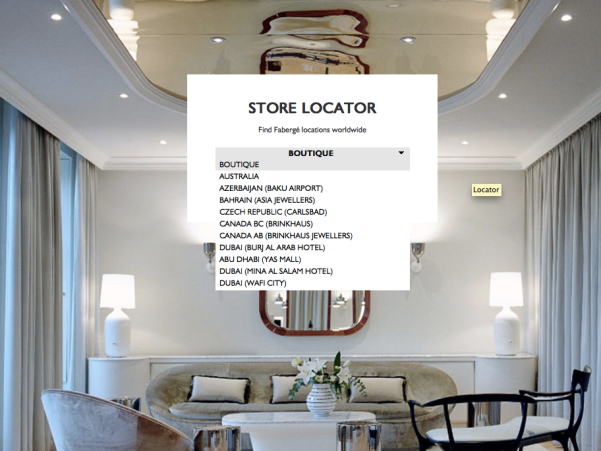
Fabergé Boutiques Worldwide
Contemporary names for Russian jewelry are ALENA GORCHAKOVA JEWELLER, CLUEV JEWELLERY, GAYDAMAK JEWELLERY…
Russians traditionally love jewelry, especially gold, the symbol of wealth and prosperity. And the Russian jewelry market is booming. Wealthy Russians can increasingly often be seen at European auctions and leaving as the surprise purchasers of exclusive pieces.

Chopard and Bulgari boutiques in Moscow
Demand for jewelry is important, especially in Moscow. Russian consumers of jewelry fall into two categories. Most buy mass-produced goods. These are people with a medium income and traditional preferences, and they usually trust Russian-manufactured jewelry. The other group comprises people whose incomes are large enough to appreciate not only the metal the jewelry is made of, but also its brand and exclusiveness. This group usually prefers foreign-made jewelry. Foreign players are present in the Russian market with boutiques in major cities.
Russian producers are quite able to make exclusive, high-quality pieces. Yet a crucial advantage in competition for buyers, apart from the quality, is a well-known brand name. An important trend in the sector’s development is its ongoing restructuring, and creation of vertically integrated systems of production and sales. For example, the diamond producer Alrosa intends to create a company for the luxury jewelry market and it is expected to create a jewelry brand.Overall, the Russian Jewelry market has some good potential but a provided a number of administrative obstacles are lifted to allow the market to develop effectively.
Russia is therefore undeniably a land of Jewelry. Thanks to Peter I Great, some treasures are kept at the Diamond Fund in Moscow and one can admire what is told to be one of the most incredible collections of Jewelry in the World.
Russia’s earth itself provides a significant amount of diamonds and precious stones, which are produced in unique conditions in the world.
Faberge is certainly one of the most astonishing Russian jewelers, well known for its eggs of unequaled value and it remains, today, a brand of great importance and the most important Russian brand.
The Russian Jewelry market has its particularities and remains of great perspectives for foreign Jewelry brands as well as Russian brands.
And…
Michelle Obama tours the Kremlin and the Diamond Fund article !
Sources:
http://www.e-mj.com/features/3237-diamond-mining-in-russia.html